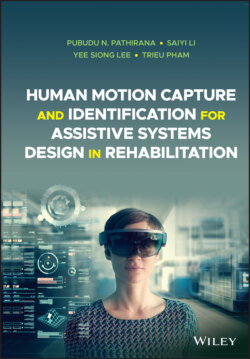Читать книгу Human Motion Capture and Identification for Assistive Systems Design in Rehabilitation - Pubudu N. Pathirana - Страница 20
1.3.3 Inertial measurement unit (IMU)
ОглавлениеInertial measurement unit (IMU) is a device that mainly measures angular velocity, orientation, gravitational force and magnetic direction. In an early stage of the development of the IMU, a gyroscope and an accelerometer were usually utilised to provide angular velocity and inertial acceleration. Later on, integration of a magnetometer enabled an IMU to measure magnetic direction. As a result, measurements from an IMU can be more accurate [20]. As all these sensors are able to provide three‐dimensional measurements, the IMU is widely utilised in movable applications, such as for aircraft navigation [398].
Recently, thanks to the advancement in a micro‐electromechanical system (MEMS), IMUs can be produced in a size small enough to be worn by human beings. As a result, in recent years, more and more applications of IMUs have been seen in rehabilitation and telerehabilitation fields as human motion capture devices [20]. Currently, there have been a number of companies producing and selling IMU sensors, for example Xsens®, YEI Technology®, MotionNode® and so on (see Figure 1.8). These products can be attached on humans for motion tracking. Using 19 sensors in a full-body suit, Rokoko Smartsuit Pro™[5] captures full-body motions using IMU sensors in real time and is available as a commercial product.
In a small number of applications, a single IMU is used to monitor specific conditions (usually relating the movement of one joint) in telerehabilitation. For instance, Giansanti et al. [116] utilised an IMU with one three‐axis accelerometer and a gyroscope to detect the risk of falling in telerehabilitation. The other example is Han et al. [141], who integrated a 6 degrees of freedom (6DOF, including three-axis accelerometer and gyroscope) IMU with a customised ankle foot orthosis (AFO) to provide a telerehabilitation diagnostic service for patients with two types of conditions, including those with muscle weakness because of brain injuries and those who were about to receive total knee replacement surgery due to osteoarthritis of knee joints. Experiments in the study confirmed the high sensitivity and specificity of the AFO‐IMU module in measuring the flexion and extension motions of knee joints.
However, it is obvious that a single IMU is insufficient to monitor the movement involving multiple joints, such as upper extremity movements and whole body movements. Therefore, a body area network (BAN) or a body sensor network (BSN) was developed to fill this gap. For instance, Nerino et al. [257] proposed a BSN to provide knee telerehabilitation services to patients with anterior cruciate ligament (ACL). In the proposed system, multiple IMUs with 9 DOF (including a three‐axis accelerometer, gyroscope and magnetometer) were attached to the thigh, calf and foot, thus enabling measurements to be taken of the angle of the knee and ankle. After comparing this to the Vicon system, the average angular errors measured by the BSN on the knee and ankle were 2.4° and 3.1° with a standard deviation of 1.8° and 2.4°, respectively. Horak et al. [145] summarised the role played by body‐worn movement monitor devices in rehabilitation services for balance and gait. Cancela et al. [61] evaluated the wearability of a BAN‐based system, named PERFORM, to monitor the symptoms of patients with PD. This system is composed of four tri‐axial accelerometers locating on two legs and two arms, respectively, and a central sensor with one tri‐axial accelerometer and gyroscope positioned on the waist (refer to Figure 1.9). Analysis was conducted considering comfort, biomechanical and physiological aspects of the system. According to the experiment, it was found that patients were generally satisfied to wear such a system. However, some patients were concerned about their privacy, as well as how others might think about them particularly in a public area, thereby showing a bit of anxiety and unwillingness to use this system. Furthermore, the strap made patients uncomfortable and difficult to wear when by themselves. Last, but not least, feedback was necessary during monitoring so that patients knew the system was working properly.
Figure 1.9 Locations of five sensors worn by a subject. Source: Cancela et al. [61].
